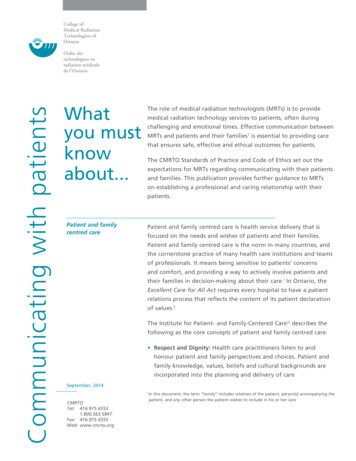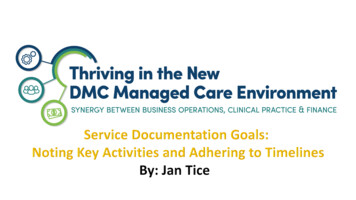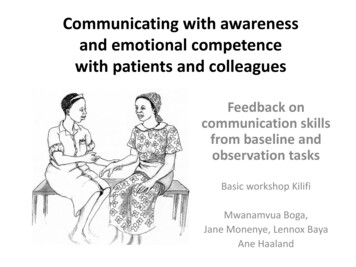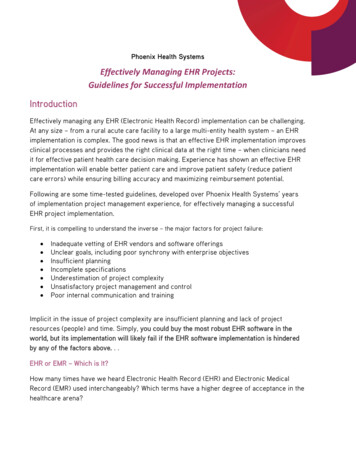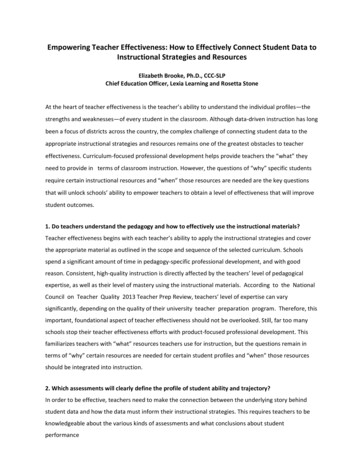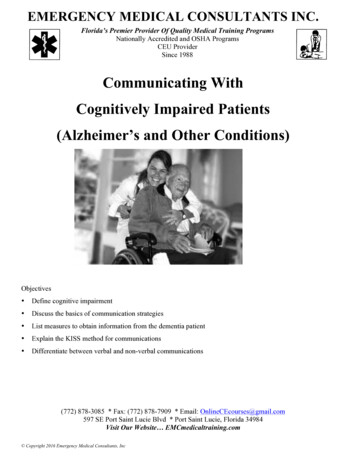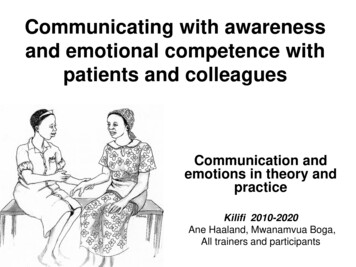
Transcription
Communicating with awarenessand emotional competence withpatients and colleaguesCommunication andemotions in theory andpracticeKilifi 2010-2020Ane Haaland, Mwanamvua Boga,All trainers and participants
Communicating about clinicalcare and research withpatients and colleaguesCommunication andemotions in theory andpracticeKilifi 2010-2020Ane Haaland, Mwanamvua Boga,All trainers and participants
ObjectivesTo create awareness about––––Where we are in the learning processThe history of developing the training modelThe aims and contents of the courseThe gaps in communication skills training for providers, from theresearch literature– Our approach building on research evidence, and – on participants’needs for learning– The concepts underlying the courseTo strengthen skills in– Using appreciation as a communication method, and– Reflecting on the effects of using this method, on participants’emotions
Overview: Our learning processParticipants – (add – how many are in the course,where/institution they come from)Preparation (Phase 1)––––Baseline questionaireObservation and reflection tasks - Pack 1 – communication skillsPack 2 - emotionsPack 3 – research/anxiety, medical terms, PCCNow: Workshop 1: 5 days Intensive course (Phase 2)Next phase (3): Putting skills into practice (Time/dates: 3months, 3 packs of observation tasks)Endline questionaire (date)Final phase (4): Follow up workshop, 3-4 days (date)
Reflective learning process – 9 months:Changing habits takes time Phase 1: Self-observation and reflection(3-4 months’ independent on the job learning)– Awareness building: Weekly tasks – to discover.Narratives. Phase 2: Workshop (5 days)– Links observations to theory and practice, using experiencebased learning and reflective practice Phase 3: Skills into practice (3 months)– Observation and informed reflection in daily routine work, tostrengthen self-awareness Phase 4: Follow-up workshop (3 days)– Summarizes and anchors learning to daily challenges
History of the training project Process training approach, contents, methods andtools developed with users/providers by AneHaaland with Norwegian NGO 2006-08 Implemented and refined in Lithuania, Tanzania,Nambia, Zambia, Latvia, Russia and UK/Wales Two Kenyan nurses (J. Chakaya and M. Boga)participated in Zambia 2008Participants and trainer,Lithuania 2006 Took initiative to adapt implement process in Kilififrom 2009, and added research aspect. AH lead process and training. M. Boga took overas lead trainer and coordinator in Kilifi in 2012 Course now run independently in Kilifi M Boga took course to Gambia, 2015-17 Course run for trainee doctors, Wales UK, 2016-17Trainers w/ AH, Kilifi 2012
Literature reviews: Problems incommunication training for providers*Contents, methods and approach: Focus on:– Mechanistic – not relational communication– Theory, not practice– Cognitive learning, not including emotions Lack of focus on– Importance of building relationship and trust– Why and how to relate to patients as persons– Awareness and management of emotions; building self-awareness– Contents not based on providers’ daily challenges in clinical practice– Learner-centered methods, and practice of new skills in work contextOutcome Training does not lead to improved communication practice No effect on behavior change, or patient outcome* Reviews on evaluation of training for nurses, Europe and the US
Useful resources and links onemotions and EI Link to Emotional Intelligence article http://m.huffpost.com/us/entry/us 5952b6b8e4b0c85b96c65d4e Interesting Ted Talks: https://www.ted.com/talks/brene brown on vulnerability?language nb andhttps://www.ted.com/talks/brene brown listening to shame?language nb https://www.youtube.com/watch?v ISbsGGK8vvISusan David http://heartsinhealthcare.com/doctors-dont-cry/
Research: Effective communication skillstraining characterized by: Longitudinal, using reflectionSafe learning environmentExperiential learning methodsActive small group learningUse in clinical practiceCritical reflectionFocus on emotions, not onthoughts aloneAim: Develop professional identity Core human valuesVan Weel-Baumbarten, E (2010): Best EvidenceTeaching Communication Skills. Presentation to thethird Geneva conference on Person-centeredMedicine, Geneva May 3-5th 2010.*Branch, W: Teaching professional andhumanistic values: Suggestion for a practicaland theoretical model. PCC 2015
Overall training aim:Strengthen knowledge, skills and self-awarenessto communicate with emotional competenceDiscover why you may blamepatients - and why and howcommunicating with awareness andrespect for emotions, works better
Aims of the training processGeneral: To strengthen providers’ Awareness of what facilitates and whathinders good communication with patientsand colleagues Skills to communicate professionally withrespectPersonal: To strengthen your Awareness of how you communicate withothers, and of the effects of your owncommunication habits, on the other person Skills to recognize and manage your ownand patients’ emotions with awareness andrespectResearch: To strengthen providers’ Skills to communicate about research,with emotional competence.
Overview – Contents workshop 1 When and how do adults learn best Basic communication theory and skills, related to clinicalcare research The effect of emotions on communication – and how tobuild emotional competence Why do conflicts occur, how to handle them How to step back to see a situation clearly The effect of blaming and judging patients, on learningand adherence Understanding and handling anger, fear and insecurity How do people change attitudes and behavior Communication strategies
Course approach:Supportive process learning Theory founded course Participants’ observations andreflections basis foradapting course contents By using your own situations,learning will be relevant Practice with feedbackbridges knowledge and skills
Key concepts in learning and practising goodcommunication with patients, colleagues and supervisors- aiming for Patient centred care1. Awareness
Example from participants “I found that listening to my clients withoutinterfering as they talk to me was good as it gavethem time to explain all their complaints and gaveme time to think about their problems”. “Have realized that I am a poor listener and I don’tpay attention to instructions. Sometimes I interruptwhen one is talking with my own opinion. I havebeen harsh, rude and most people told me that Iam always serious and thus fear me.”
Key concepts: 2Critical thinking; Reflection, insights
Example - insights “I never knew “listening know-how iscommunicating know-how”. I learnt that when aminvolved in a conversation, I have to bear in mindthat the person I am talking to is much moreinterested in himself, his needs and his problems’ “Medicine is strange to non medics, so we need toengage patients clients and their relative inmanagement and to succeed in this we have tocommunicate effectively.”
Example- Reflections “I left the place while full of anger and I could notcontrol it, I went straight to my bed without takinganything I tried to meditate the story, “how has itstarted? The way I am tired? How should Ihandle this case?” “After settling the issue I took time to go throughmyself over the whole situation. I visualized how itstarted, how I contributed and what I went throughin the process”
Key concepts: 3Respect
Examples from participantsHow do you feel when treated with respect? “I feel good and appreciate it, I also ensure I give thatperson twice the respect they gave me” “I feel great, am motivated to do better and even respect theother person”When treated without respect? “When I sense disrespect from someone geared towardsme. I feel bad, angry and it I decide to react then I can tellwhat I think about that person” I feel offended feel demoralized and my moral goes down”
Key concepts: 4Empathy
Example “I carry so much of thepatient’s burden(sickness) and really feelfor the patient and mostof the time I put myself inthe patient’s shoes”
Key concepts: 5Humanistic medicine Interdisciplinary From Disease-centred toPatient-centred care Aims:– Open communication– Mutual respect– Emotional connectionbetween HP patient
Examples “I can now have ample time with a client and get to knowhis/ her other needs apart from what has brought himlike the physical needs which is the sickness, because ifyou don’t meet all her needs she will be there physicallyand be disturbed emotionally and she won’t really takegood care of the sick child. PCC is a very good element and if well applied we willhave such a good world to live in where patients willnever be mismanaged and taken care of very well.”
Key concepts: 6Appreciation
Examples ”If a person is appreciated for what he/she is, andher/his opinion is respected, there is always positiveattitude in them that motivates them to give moreinput.” Effect of appreciation: “I feel safe when patients show and explain their faithin you and in what you are doing to help. Also whenthey explain their gratitude to you after getting better. “
Key concepts: 7ResponsibilityYou cannot change others. You can take responsibility for own change
Examples “Thanks to this course, I have tried to learn a lotand have broken the barriers that are hindering meto communicate effectively. I have realized that Iam the problem when it comes to communication. Ihave decided to have a change and that change isme!” ‘I think I need to put more words into myexplanations because sometimes I use very fewwords/ statements hence somebody can’tunderstand”
Key concepts: 8Motivation
Example “When I am treatedwith respect, I feelhappy, absolutelyhonoured, my levelsof motivation areusually high andnaturally take to myheart the wholesituation”
Key concepts: 9Empowerment
Example “I have adopted a pattern of seeking to know what myclients already know from what subject we arediscussing .I encourage then to tell me everything so thatI only add to what they may have forgotten or omitted.When I respond in my own opinion, the client feels leftout not of a decision, unlike when I make the client anactive participant, I realize that he owns the decisionmade and if it requires change he becomes a forerunnerfor the change expected”
Key concepts: 10Handling conflicts throughconscious communicationFrom Persuasion .To Dialogue
Examples “I confront at the right time especially when the person Ihave had a conflict with, I keep the communication open sothat we can resolve the issue between us. I acknowledge theproblem and if am on the wrong I never hesitate to apologise” “It doesn’t matter how hurt we are. Approaching the otherperson in a calm manner and with respect can help solve aproblem. We should stop thinking of the person who irritatesus and focus on way forward to solving the problem. Wealways need change immediately when angered but it’s goodto have self control otherwise the end could be destructive.”
Key concepts: 11Have fun – why?Research shows:When participantsenjoy learning, theylearn better
Communicating about ResearchChallenges in communicating about research. “Fear of explaining complications/ risks/assuring patientsof their safety to participate in research” “Not able to listen, asking questions/exploring patientsfeelings about research” Concept we use to communicate clinical careapplicable to research
Our expectationsWe expect that during the course, you will: Find the contents relevant to your situation andneeds Work hard Take with you:– New insights, ideas, skills and questions;– A motivation to use the new learning to take action inyour work You will tell us when something is not clear, ordoes not feel right You will participate to the best of your ability
Introductions: Our resources Sit in groups of 3, withcolleagues you know Tell colleagues what youappreciate about them – howthey are a resource Let other colleagues add Be generous, and honest Discuss your expectations forthis week Each group presents theirmembers, and expectations
Literature: Problems incommunication training for providersLack of communication skills in healthcare Lack of clarity in defining theoretical base for curriculum planning and delivery. Nocoherent strategy for teaching communication skills.Focus on mechanistic – not relational communication Emphasis is on learning concrete, discrete behavioral actions, and learning “lists ofskills”. Needed: on natural capacity for connection and relationship formation: caring and communication are inseparably linked. You cannot hope tocommunicate effectively if you do not care about the person on the receiving end.Poor evaluation of course outcomes Uncertainty amongst educators about what is good practice in communication skillsteaching. Lack of research, and lack of evidence concerning effectiveness of differenteducational interventions. Rating student satisfaction, rather than patient satisfaction.Teaching not adapted to learning styles of students Failure to adjust to individual needs or abilities of students – they have differentlearning styles which influence the impact of training. Failure to meet needs of students was a key deficiency
Literature, cont.Gap between theory and practice Segmentation between education and work is a major barrier to effective and appropriatecommunication skills teaching.Barriers to using communication skills in practice nurses not only need good skills, they also have to have an environment open to goodcommunication. Relationship: Occupational stress, burnout and social support. Lack of support structures for patients to enable them to cope with emotional distress, whichhinders ability to communicate effectively.Workplace policies and practice; hierarchy Traditional organization of nursing work, and fear of dealing with emotional distress, are barriers toempathy and communication skill implementation Modification in workload can lead to increased level of therapeutic listening by staff, and improvedpatient satisfaction Hierarchical structure of healthcare deters students and nurses from attempting to implementcommunication skills knowledge in practice. If communication skills are to be applied, more egalitarian and cooperative relationships betweendifferent professionals, regardless of perceived status, authority or power, is essential.Lack of focus on patient-centered approach Very few studies have investigated patients’ experiences and perceptions of how nursescommunicate. Nurses can communicate well when they use a patient-centred approach. However, health careorganizations do not appear to value or recognize the importance of nurses using such approachwhen communicating with patients to ensure delivery of quality patient care.
– The gaps in communication skills training for providers, from the research literature – Our approach building on research evidence, and –on participants’ needs for learning . patients - and why and how communicating

